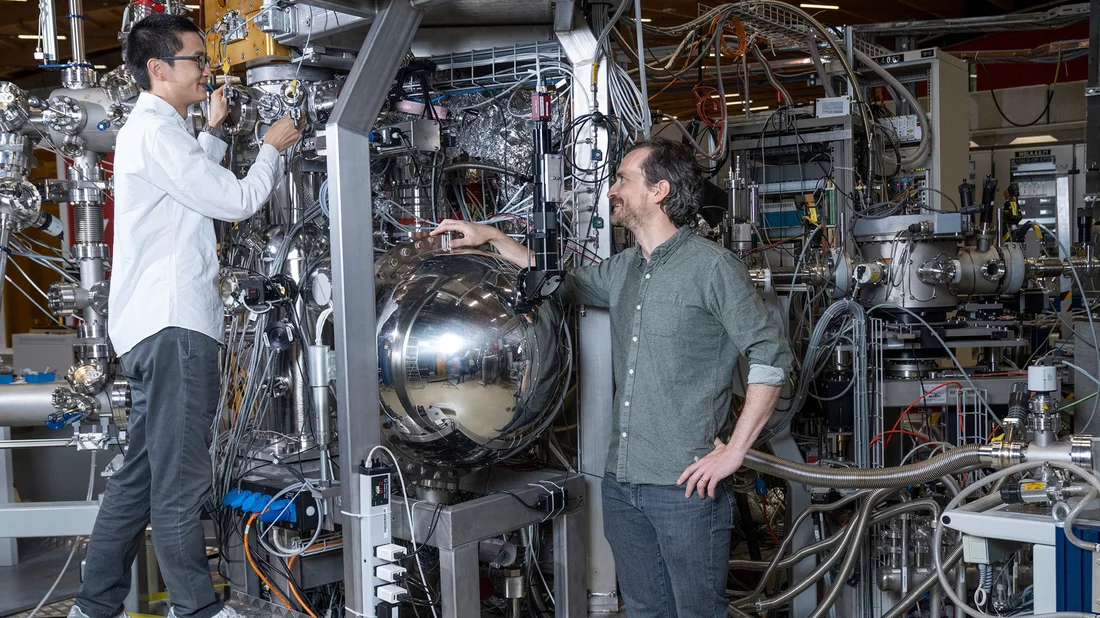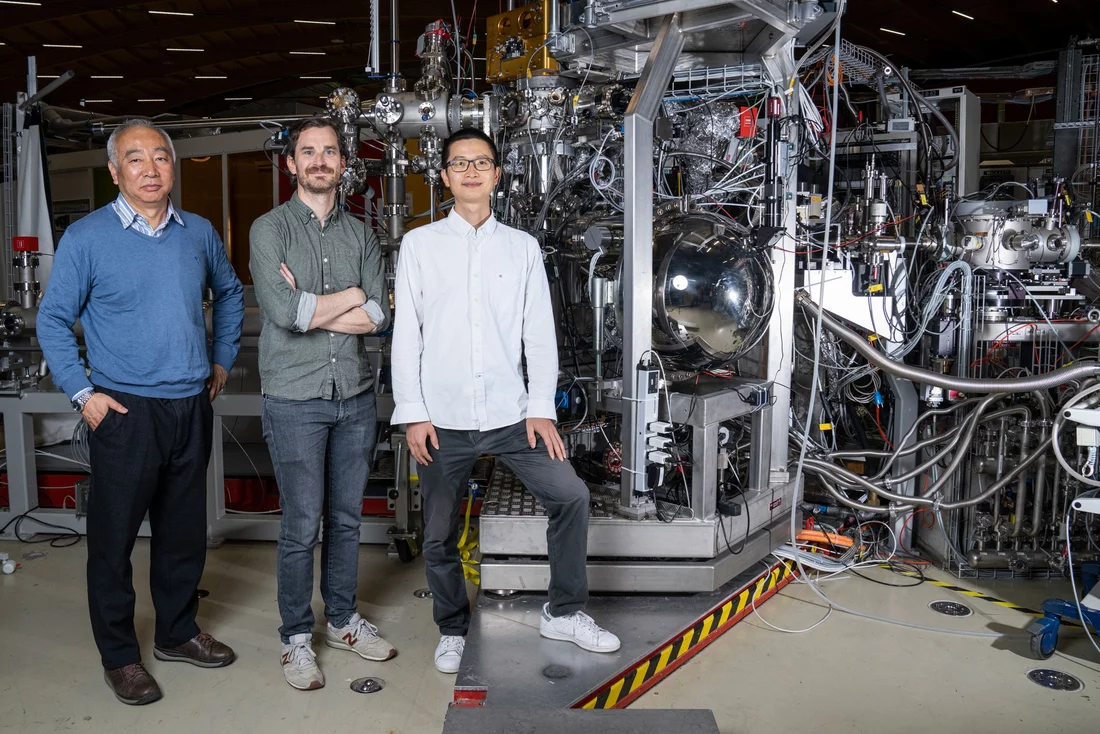The recently discovered layered kagome metals AV3Sb5 (A=K, Rb, Cs) exhibit diverse correlated phenomena, thought to be linked to so-called Van Hove singularities (VHSs) and flat bands in the material. Using a combination of polarization-dependent angle-resolved photoemission spectroscopy (ARPES) and density-functional theory, researchers led by Professor Ming Shi at the Paul Scherrer Institute directly revealed the sublattice properties of 3d-orbital VHSs and flat bands, as well as topologically non-trivial surface states in CsV3Sb5. The research reveals important insights into the material’s electronic structure and provides a basis for understanding correlation phenomena in the metals.
So-called kagome metals, named after the Japanese woven bamboo pattern their structure resembles, feature symmetrical patterns of interlaced, corner-sharing triangles. This unusual lattice geometry and its inherent features lead, in turn, to curious quantum phenomena such as unconventional, or high-temperature, superconductivity.
The potential for devices that might transport electricity without dissipation at room temperature—as well as a thirst for fundamental theoretical understanding—have led researchers to investigate this new class of quantum materials and try to figure out how electrons interact with the kagome lattice to generate such remarkable features.
A recently discovered class of AV3Sb5 kagome metals, where A can be =K, Rb or Cs, was shown, for instance, to feature bulk superconductivity in single crystals at a maximum Tc of 2.5 K at ambient pressure. Researchers suspect that this is a case of unconventional superconductivity, driven by some mechanism other than the phonon exchange that characterizes bonding in the electron-phonon coupled superconducting electron-pairs of conventional superconductivity.
This, as well as other exotic properties observed in the metal, are thought to be connected to its multiple “Van Hove singularities” (VHSs) near the Fermi level. VHSs, associated with the density of states (DOS), or set of different states that electrons may occupy at a particular energy level, can enhance correlation effects when a material is close to or reaches this energy level. If the Fermi level lies in the vicinity of a Van Hove point, the singular DOS determines the physical behavior due to the large number of available low-energy states. In particular, interaction effects get amplified not only in the particle-particle, but also in the particle-hole channels, leading to the notion of competing orders.
Because these VHSs enhance correlation effects, it’s critically important to determine their nature and properties. This is what prompted researchers led by Professor Ming Shi, senior scientist at the Photon Science Division at the Paul Scherrer Institute, to investigate the metal further. They not only identified two types of VHSs, but also observed flat bands and topologically non-trivial surface states. The paper “Rich Nature of Van Hove Singularities in Kagome Superconductor CsV3Sb5,” and “Topological surface states and flat bands in the kagome superconductor CsV3Sb5,” recently published in Nature Communications and Science Bulletin, reports on their findings.
VHSs can be classified into two types, conventional and higher-order, and each is associated with distinctive features: conventional van Hove singularities involve a logarithmic singularity but higher-order VHS show a power-law divergent DOS. Moreover, VHSs in kagome lattices possess distinct features in the sublattice that lead to a reduction of the local electrostatic interactions between electric charges, effectively enhancing the role of non-local effects.
To investigate the phenomena, the researchers combined the experimental approach of polarization-dependent angle-resolved photoemission spectroscopy (ARPES) at the Surface/Interface Spectroscopy (SIS) beamline of the Swiss Light Source (SLS) with the theoretical approach of density functional theory to directly reveal the sublattice properties of VHSs in the metal.
They identified four VHSs, three of which are close to the Fermi level. One of them, just below the Fermi level, displays an extremely flat dispersion, establishing the experimental discovery of higher-order VHS, the researchers said. This, and other features, are generalized to the AV3Sb5 family of kagome metals and have a wide range of important physical implications, detailed in the paper.
Overall, the appearance of multiple types of VHSs near the Fermi level, derived from the multi-orbital nature, can induce a rich competition for various pairing instabilities and therefore generate numerous different orders depending on small changes in the electron filling. This means that researchers may be able to access and even tune the orders in these metals through carrier doping or external pressure. Both approaches should be further investigated through experiment and theory, the researchers said.
Text: Based on a Press Release by NCCR MARVEL / Carey Sargent with additions from Paul Scherrer Institut
Contact
Dr. Ming Shi
Senior Scientist
Spectroscopy of Novel Materials group
Paul Scherrer Institute
Forschungsstrasse 111
5232 Villigen PSI
Switzerland
Telephone: +41 56 310 23 93
Email: ming.shi@psi.ch
Original Publication
Rich nature of Van Hove singularities in Kagome superconductor CsV3Sb5
Yong Hu, Xianxin Wu, Brenden R. Ortiz, Sailong Ju, Xinloong Han, Junzhang Ma, Nicholas C. Plumb, Milan Radovic, Ronny Thomale, Stephen D. Wilson, Andreas P. Schnyder & Ming Shi
Nature Communications 13, 2220 (2022).
DOI: 10.1038/s41467-022-29828-x
Open access link.
Topological surface states and flat bands in the kagome superconductor CsV3Sb5
Yong Hu, Samuel M. L. Teicher, Brenden R. Ortiz, Yang Luo, Shuting Peng, Linwei Huai, Junzhang Ma, Nicholas C. Plumb, Stephen D. Wilson, Junfeng He & Ming Shi
Science Bulletin 67 (2022)
DOI: 10.1016/j.scib.2021.11.026
Further Information
Spectroscopy of Quantum Materials Group | SPECNOVMAT Group | Paul Scherrer Institut (PSI)
Funding
This work was supported by the National Centre of Competence in Research (NCCR) MARVEL.
Copyright
PSI provides image and/or video material free of charge for media coverage of the content of the above text. Use of this material for other purposes is not permitted. This also includes the transfer of the image and video material into databases as well as sale by third parties.


